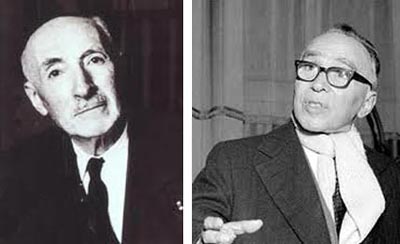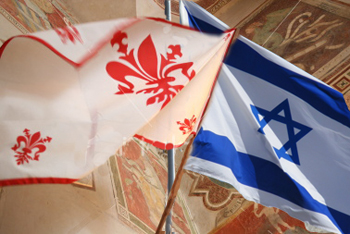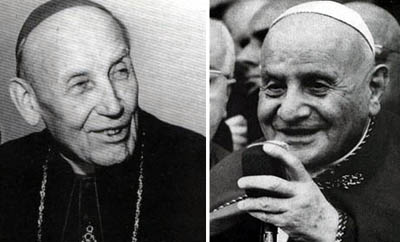Socio-Political Issues
 |
 |
 |
 |
 |
 |
 |
La Pira: A Catholic Communist - Part IV
La Pira’s Preferential Option for the Jews
Among the most spectacular innovations of La Pira’s revolutionary profile was the “dialogue” that he conducted with major Jewish representatives not only in Florence but also on the international level. The year 1950 marked his historic encounter with Jewish historian Jules Isaac, the founder of the international Jewish-Christian Friendship movement.
 The immediate outcome of this “dialogue” was the establishment in Florence of the first Jewish-Christian Friendship Association of Italy with the backing of La Pira and Jules Isaac. (1) The avowed aim of this Association was to combat anti-Semitism, but this was not a problem in Italy at that time. Even the American Jewish Committee admitted that during that period “anti-Semitism in Italy did not exist on any significant scale.” (2)
The immediate outcome of this “dialogue” was the establishment in Florence of the first Jewish-Christian Friendship Association of Italy with the backing of La Pira and Jules Isaac. (1) The avowed aim of this Association was to combat anti-Semitism, but this was not a problem in Italy at that time. Even the American Jewish Committee admitted that during that period “anti-Semitism in Italy did not exist on any significant scale.” (2)
So, what was the point of La Pira’s Isaac-inspired initiative? Just friendly dialogue? Hardly. This was startlingly innovative in itself because it involved the creation of an entire alternative world, the world of ecumenism, and a whole new theology of “relationships,” which stood in opposition to what the Catholic Church had always preached about relations with other religions.
La Pira’s activities in this area were supported by eminent Vatican figures: Archbishop Montini (later Pope Paul VI), Cardinals Journet, (3) Roncalli (later Pope John XXIII), Bea and Willebrands. These were the main Prelates who succeeded in gaining a critical mass of influence over all the participants at Vatican II and ensuring the safe passage of the document on the Jews, Nostra aetate, in the teeth of opposition from the traditional Bishops.
La Pira helps prepare the ground for Nostra aetate
With friends like these, La Pira was able to act as an underground agitator covertly working to convince the Catholic population that the real problem was not Judaism as a religion but rather the traditional doctrine of the Catholic Church regarding the Jews. He was not, of course, the only Catholic layman working behind the scenes with the Hierarchy before Vatican II to manipulate public opinion on the Jewish question. There were others such as Jacques Maritain, whose wife was of Jewish origin, pulling the strings as well.
It makes us shudder to see with hindsight the duplicity and cynical abuse of our trust by those who were conniving to undermine traditional Catholic doctrine and values. La Pira’s covert work became not only a blueprint for Nostra aetate, but also a catalyst for changes in the catechism, textbooks on theology and even the Good Friday liturgy of Paul VI’s New Mass.
La Pira’s involvement with Jewish interests was considerable and multi-faceted. In Florence alone, he never missed an opportunity to participate in and help organize Jewish ceremonies such as the celebration of the founding of the local synagogue or the signing of the golden book for the Jewish National Fund. (4)
 And there was a political element involved as well: In order to demonstrate his personal recognition of the State of Israel, La Pira held a ceremony in December 1955 for his Jewish friends in the Palazzo Vecchio where he placed the Israeli flag alongside the Banner of Florence. (5)
And there was a political element involved as well: In order to demonstrate his personal recognition of the State of Israel, La Pira held a ceremony in December 1955 for his Jewish friends in the Palazzo Vecchio where he placed the Israeli flag alongside the Banner of Florence. (5)
All these extraordinary initiatives need to be seen in the context of future developments leading to the cataclysmic event of the 1960s – Vatican II – and the ensuing debacle that has been afflicting the Church ever since. It is only by examining the evidence of La Pira’s activities with Jewish representatives (6) that we can see what part he played in helping Vatican II to destroy the Church’s sense of her own identity.
And here we get to the core of La Pira’s profound belief that the Church is an all-inclusive society based on the brotherhood of man – or if she wasn’t, then she should be. In this way, he reflected the progressivist idea that the traditional Catholic teaching on the Jews was racist and anti-Semitic and would have to be changed.
La Pira’s collaboration with Jules Isaac
That was the basic aim of Jules Isaac, the Jewish lobby’s most influential spokesman who had been trying for years before Vatican II to change the Church’s Gospel-based doctrine on the Jews. Isaac sought and obtained an interview with Pope John XXIII on June 13, 1960. On that occasion he presented the Pope with his thesis that it was Catholic doctrine (he had coined the phrase “teaching of contempt”) that led to anti-Semitism and the horrors of the “Holocaust.”
In a breathtaking display of bullying arrogance, Isaac asked the Pope to “correct the errors” of the Catholic Faith and “purify” the Church of her “inherent anti-Semitism.” He proposed nothing less than a revision of the Gospels as well as the writings of the Fathers and Doctors of the Church – a clear indication of Isaac’s own “teaching of contempt” for the Catholic Faith.
 John XXIII, however, responded positively, assigning Card. Augustine Bea, S.J., who was then head of the Secretariat for Promoting Christian Unity, to place the issue on the Council's agenda. It was not until 1965 with the issuing of Vatican II’s Nostra aetate that Jules Isaac’s intervention finally succeeded. The result was that centuries of Catholic values enshrined in the Church’s doctrine, liturgy, legal system and institutions had to be altered to accommodate the demands of certain non-Catholic and even anti-Catholic individuals.
John XXIII, however, responded positively, assigning Card. Augustine Bea, S.J., who was then head of the Secretariat for Promoting Christian Unity, to place the issue on the Council's agenda. It was not until 1965 with the issuing of Vatican II’s Nostra aetate that Jules Isaac’s intervention finally succeeded. The result was that centuries of Catholic values enshrined in the Church’s doctrine, liturgy, legal system and institutions had to be altered to accommodate the demands of certain non-Catholic and even anti-Catholic individuals.
The implications of this covert act of treachery are shocking. What other religion is expected to provide its detractors with the opportunity to attack it? What other religion expects itself to make such a provision?
La Pira’s tribute to Jules Isaac
As president of Jewish-Christian Friendship Association, La Pira organized on his own initiative a conference in the Palazzo Vecchio on May 3, 1964, to commemorate Isaac’s achievements in the field of inter-faith activity. (7) The conference was attended by civil and ecclesiastical dignitaries representing different religions.
It is reported that La Pira described the late Prof. Isaac as “the founder and apostle of Hebrew-Christian friendship” and “called for the conference to be opened up to Jews, Christians and Moslems.” (8) In a letter published in the Florence daily, Giornale del Mattino, he stated that the conference was an “act of worship of the Lord” and a “bond of grace, unity and peace for the three-fold family of Abraham.” (9)
Not content with this syncretist commemoration ceremony, La Pira collaborated with his Jewish friends to produce a dossier of Jules Isaac’s thesis and distributed it to each of the Council Fathers who were in session at Vatican II. Each copy was accompanied by a personal letter from La Pira instructing them on the “prophetic” nature of the conference and admonishing them to give it their particular attention. (10)
La Pira continued to conspire with his Jewish associates to change the Church’s age-old position on the Jews as my next article will show.
Continued

Posted April 24, 2013

Jules Issac, left, and Giorgio La Pira, right, co-founded the JCFA in Florence to change the Church's position on the Jews
So, what was the point of La Pira’s Isaac-inspired initiative? Just friendly dialogue? Hardly. This was startlingly innovative in itself because it involved the creation of an entire alternative world, the world of ecumenism, and a whole new theology of “relationships,” which stood in opposition to what the Catholic Church had always preached about relations with other religions.
La Pira’s activities in this area were supported by eminent Vatican figures: Archbishop Montini (later Pope Paul VI), Cardinals Journet, (3) Roncalli (later Pope John XXIII), Bea and Willebrands. These were the main Prelates who succeeded in gaining a critical mass of influence over all the participants at Vatican II and ensuring the safe passage of the document on the Jews, Nostra aetate, in the teeth of opposition from the traditional Bishops.
La Pira helps prepare the ground for Nostra aetate
With friends like these, La Pira was able to act as an underground agitator covertly working to convince the Catholic population that the real problem was not Judaism as a religion but rather the traditional doctrine of the Catholic Church regarding the Jews. He was not, of course, the only Catholic layman working behind the scenes with the Hierarchy before Vatican II to manipulate public opinion on the Jewish question. There were others such as Jacques Maritain, whose wife was of Jewish origin, pulling the strings as well.
It makes us shudder to see with hindsight the duplicity and cynical abuse of our trust by those who were conniving to undermine traditional Catholic doctrine and values. La Pira’s covert work became not only a blueprint for Nostra aetate, but also a catalyst for changes in the catechism, textbooks on theology and even the Good Friday liturgy of Paul VI’s New Mass.
La Pira’s involvement with Jewish interests was considerable and multi-faceted. In Florence alone, he never missed an opportunity to participate in and help organize Jewish ceremonies such as the celebration of the founding of the local synagogue or the signing of the golden book for the Jewish National Fund. (4)

La Pira raised the Florence and Israeli flags side by side in the Palazzo Vecchio
All these extraordinary initiatives need to be seen in the context of future developments leading to the cataclysmic event of the 1960s – Vatican II – and the ensuing debacle that has been afflicting the Church ever since. It is only by examining the evidence of La Pira’s activities with Jewish representatives (6) that we can see what part he played in helping Vatican II to destroy the Church’s sense of her own identity.
And here we get to the core of La Pira’s profound belief that the Church is an all-inclusive society based on the brotherhood of man – or if she wasn’t, then she should be. In this way, he reflected the progressivist idea that the traditional Catholic teaching on the Jews was racist and anti-Semitic and would have to be changed.
La Pira’s collaboration with Jules Isaac
That was the basic aim of Jules Isaac, the Jewish lobby’s most influential spokesman who had been trying for years before Vatican II to change the Church’s Gospel-based doctrine on the Jews. Isaac sought and obtained an interview with Pope John XXIII on June 13, 1960. On that occasion he presented the Pope with his thesis that it was Catholic doctrine (he had coined the phrase “teaching of contempt”) that led to anti-Semitism and the horrors of the “Holocaust.”
In a breathtaking display of bullying arrogance, Isaac asked the Pope to “correct the errors” of the Catholic Faith and “purify” the Church of her “inherent anti-Semitism.” He proposed nothing less than a revision of the Gospels as well as the writings of the Fathers and Doctors of the Church – a clear indication of Isaac’s own “teaching of contempt” for the Catholic Faith.

John XXIII asked Cardinal Bea, left, to place the Jewish complaints in the Council's agenda
The implications of this covert act of treachery are shocking. What other religion is expected to provide its detractors with the opportunity to attack it? What other religion expects itself to make such a provision?
La Pira’s tribute to Jules Isaac
As president of Jewish-Christian Friendship Association, La Pira organized on his own initiative a conference in the Palazzo Vecchio on May 3, 1964, to commemorate Isaac’s achievements in the field of inter-faith activity. (7) The conference was attended by civil and ecclesiastical dignitaries representing different religions.
It is reported that La Pira described the late Prof. Isaac as “the founder and apostle of Hebrew-Christian friendship” and “called for the conference to be opened up to Jews, Christians and Moslems.” (8) In a letter published in the Florence daily, Giornale del Mattino, he stated that the conference was an “act of worship of the Lord” and a “bond of grace, unity and peace for the three-fold family of Abraham.” (9)
Not content with this syncretist commemoration ceremony, La Pira collaborated with his Jewish friends to produce a dossier of Jules Isaac’s thesis and distributed it to each of the Council Fathers who were in session at Vatican II. Each copy was accompanied by a personal letter from La Pira instructing them on the “prophetic” nature of the conference and admonishing them to give it their particular attention. (10)
La Pira continued to conspire with his Jewish associates to change the Church’s age-old position on the Jews as my next article will show.
Continued
- See the pamphlet Vent’Anni di Presenza in Città, p. 5 published by the Jewish-Christian Friendship Association of Torino, quoted here.
- The AJC (American Jewish Committee) is the foremost Jewish organization in the US and describes itself as a “global Jewish advocacy” group. See here.
- Luciano Martini (ed.), Giorgio La Pira e la vocazione di Israele (Giorgio La Pira and the Vocation of Israel), Florence: Giunti Editore, 2005, p. ix. The book consists of a collection of studies in Italian on La Pira’s relations with the Jews, and was published with the help of the La Pira Foundation to mark the 100th anniversary of his birth.
- Ibid., p, 79. This was the 75th anniversary of the founding of the Great Synagogue, the Tempio Maggiore of Florence. The golden book, also known by its Hebrew name, Keren Kayemeth LeIsrael, was established in 1948 to commemorate Chaim Weizmann, the first President of the State of Israel.
- Ibid., pp, 79-80
- Luciano Martini, using documents from the La Pira Archives, gives a detailed account of the correspondence between La Pira and several Florentine Jews. In them, La Pira worked to bring their demands for Church reform to the attention of the Catholic Hierarchy before Vatican II.
- L. Martini, Giorgio La Pira e la vocazione di Israele, p. 76
- AJR (Association of Jewish Refugees in Great Britain) Information, vol. 19 n. 6, June, 1964, p. 4. See here.
- L. Martini, Giorgio La Pira, p. 76. La Pira wrote: “un atto di adorazione per il Signore ed un cimento di grazia, di unità et di pace per la triplice famiglia di Abramo”(This is an act of adoration of the Lord and a foundation of grace, unity and peace for the three-fold family of Abraham).
- L. Martini, Giorgio La Pira, p. 77

Posted April 24, 2013
______________________
______________________











